Items filtered by date: December 2024
Key Facts About Athlete’s Foot
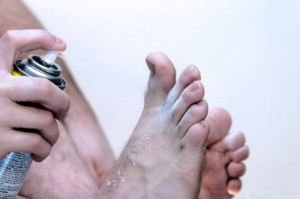
Athlete’s foot is a fungal infection that affects the skin on the feet, causing itching, burning, and peeling. It is caused by dermatophytes, a type of fungus that thrives in warm, moist environments like locker rooms, swimming pools, and public showers. The infection spreads through direct contact or by sharing contaminated items such as towels or shoes. Those who sweat excessively or wear tight, non-breathable shoes are at higher risk. Symptoms of athlete’s foot include red, scaly skin, blisters, and cracked skin, often between the toes or on the soles of the feet. If left untreated, the infection can spread to other areas of the body, including the nails or groin, and may lead to bacterial infections. Persistent infections may require stronger medications or specialized care. A podiatrist can accurately diagnose the condition and recommend the best treatment plan. If you are experiencing symptoms of athlete’s foot, it is suggested that you schedule an appointment with a podiatrist.
Athlete’s Foot
Athlete’s foot is often an uncomfortable condition to experience. Thankfully, podiatrists specialize in treating athlete’s foot and offer the best treatment options. If you have any questions about athlete’s foot, consult with one of our podiatrists from Podiatry Associates of Texas. Our doctors will assess your condition and provide you with quality treatment.
What Is Athlete’s Foot?
Tinea pedis, more commonly known as athlete’s foot, is a non-serious and common fungal infection of the foot. Athlete’s foot is contagious and can be contracted by touching someone who has it or infected surfaces. The most common places contaminated by it are public showers, locker rooms, and swimming pools. Once contracted, it grows on feet that are left inside moist, dark, and warm shoes and socks.
Prevention
The most effective ways to prevent athlete’s foot include:
- Thoroughly washing and drying feet
- Avoid going barefoot in locker rooms and public showers
- Using shower shoes in public showers
- Wearing socks that allow the feet to breathe
- Changing socks and shoes frequently if you sweat a lot
Symptoms
Athlete’s foot initially occurs as a rash between the toes. However, if left undiagnosed, it can spread to the sides and bottom of the feet, toenails, and if touched by hand, the hands themselves. Symptoms include:
- Redness
- Burning
- Itching
- Scaly and peeling skin
Diagnosis and Treatment
Diagnosis is quick and easy. Skin samples will be taken and either viewed under a microscope or sent to a lab for testing. Sometimes, a podiatrist can diagnose it based on simply looking at it. Once confirmed, treatment options include oral and topical antifungal medications.
If you have any questions, please feel free to contact our offices located in Arlington Weatherford, Mineral Wells, and Farmers Branch, TX . We offer the newest diagnostic and treatment technologies for all your foot care needs.
Gout Pain Can Be Managed
Choosing the Best Trail Running Shoes for Comfort and Performance
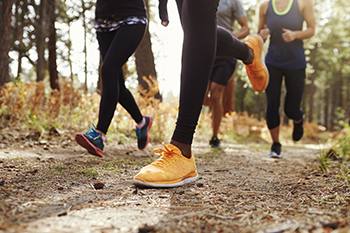
Selecting the right trail running shoes is essential for comfort and safety on rugged terrain. The first consideration is traction, as trail shoes need to provide excellent grip to prevent slipping on uneven surfaces like mud, rocks, or loose gravel. Look for shoes with deep lugs on the outsole to ensure stability. Another important factor is cushioning, which should be balanced to provide support while protecting your feet from rocks and debris without feeling too bulky. It is also essential to choose shoes with good durability and water resistance, especially for wet or rocky trails. The fit of the shoe is equally important, with enough room in the toe box to prevent blisters and ensure comfort on long runs. Consider your arch type and foot pronation to select the right level of support. Proper trail running shoes can enhance performance and reduce the risk of injury. If you have endured a foot injury from wearing the wrong shoes for your desired form of running, it is suggested that you consult a podiatrist who can offer you relief tips, and guide you on the importance of choosing the right running shoes.
You should always make sure your running shoes fit properly in order to avoid injury. For more information, contact one of our podiatrists from Podiatry Associates of Texas. Our doctors can provide the care you need to keep you pain-free and on your feet.
Choosing the Right Running Shoe for Your Foot Type
Improper shoe sizing can cause a myriad of problems for your feet. Shoes that don’t fit you properly can lead to muscular imbalances in your body, which can result in foot, knee, and hip injuries.
Tips for Finding the Right Running Shoe
- Make sure you have a thumb’s width of wiggle room between the end of your longest toe and the front of the shoe.
- There should be little to no slipping at the heel
- Don’t assume your size in one shoe brand will be your size in another
- Do not lace up your shoes too tightly
- Walk around in the store with your new shoes before you buy them
If you have any questions please feel free to contact our our offices located in Arlington Weatherford, Mineral Wells, and Farmers Branch, TX . We offer the newest diagnostic and treatment technologies for all your foot and ankle needs.
Causes of Blisters While Hiking and How to Prevent Them
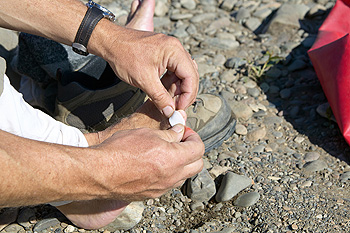
Blisters are a common issue for hikers, often caused by pressure, direct friction, and moisture. When shoes rub against the skin repeatedly during a hike, the friction creates heat, which can cause the skin layers to separate and form a blister. This is especially true if the shoes are too tight or not broken in properly. Moisture from sweat or wet conditions also plays a significant role, softening the skin and making it more prone to damage from friction. To prevent blisters, it is important to wear well-fitting shoes that provide enough room in the toe box and good arch support. Choosing moisture-wicking socks and changing them regularly can help keep feet dry. Additionally, applying blister prevention tape or lubricants to hot spots can reduce friction, keeping feet comfortable and blister-free during hikes. Foot blisters can be uncomfortable, causing patients to temporarily cease hiking. They may also become infected, needing prompt medical attention. If this applies to you, it is suggested that you contact a podiatrist who can treat foot blisters, and guide you on additional prevention techniques.
Blisters are prone to making everyday activities extremely uncomfortable. If your feet are hurting, contact one of our podiatrists of Podiatry Associates of Texas. Our doctors can provide the care you need to keep you pain-free and on your feet.
Foot Blisters
Foot blisters develop as a result of constantly wearing tight or ill-fitting footwear. This happens due to the constant rubbing from the shoe, which can often lead to pain.
What Are Foot Blisters?
A foot blister is a small fluid-filled pocket that forms on the upper-most layer of the skin. Blisters are filled with clear fluid and can lead to blood drainage or pus if the area becomes infected.
How Do Blisters Form?
Blisters on the feet are often the result of constant friction of skin and material, usually by shoe rubbing. Walking in sandals, boots, or shoes that don’t fit properly for long periods of time can result in a blister. Having consistent foot moisture and humidity can easily lead to blister formation.
Prevention & Treatment
It is important to properly care for the affected area in order to prevent infection and ease the pain. Do not lance the blister and use a Band-Aid to provide pain relief. Also, be sure to keep your feet dry and wear proper fitting shoes. If you see blood or pus in a blister, seek assistance from a podiatrist.
If you have any questions, please feel free to contact our offices located in Arlington Weatherford, Mineral Wells, and Farmers Branch, TX . We offer the newest diagnostic and treatment technologies for all your foot care needs.
Understanding Ingrown Toenail Surgery
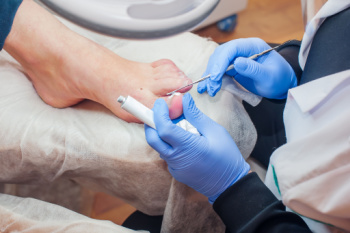
An ingrown toenail develops when the edge of the nail grows into the surrounding skin, causing pain, swelling, and redness. This common condition often affects the big toe and can lead to infection if left untreated. Symptoms include tenderness, throbbing pain, and the presence of pus or drainage. The causes of ingrown toenails include improper nail trimming, wearing tight shoes, or trauma to the toe. People with certain foot shapes or conditions like diabetes may be at higher risk of ingrown toenails. Treatment options vary depending on severity. A wedge resection is a surgical procedure in which a small portion of the nail is removed to alleviate pressure. In some cases, partial toenail removal may be recommended to prevent recurrence. If you are experiencing pain from an ingrown toenail, a podiatrist can offer effective solutions, from conservative treatments to surgery. It is suggested that you schedule an appointment with this type of doctor for treatment and relief.
Ingrown toenails may initially present themselves as a minor discomfort, but they may progress into an infection in the skin without proper treatment. For more information about ingrown toenails, contact one of our podiatrists of Podiatry Associates of Texas. Our doctors can provide the care you need to keep you pain-free and on your feet.
Ingrown Toenails
Ingrown toenails are caused when the corner or side of a toenail grows into the soft flesh surrounding it. They often result in redness, swelling, pain, and in some cases, infection. This condition typically affects the big toe and may recur if it is not treated properly.
Causes
- Improper toenail trimming
- Genetics
- Improper shoe fitting
- Injury from pedicures or nail picking
- Abnormal gait
- Poor hygiene
You are more likely to develop an ingrown toenail if you are obese, have diabetes, arthritis, or have any fungal infection in your nails. Additionally, people who have foot or toe deformities are at a higher risk of developing an ingrown toenail.
Symptoms
Some symptoms of ingrown toenails are redness, swelling, and pain. In rare cases, there may be a yellowish drainage coming from the nail.
Treatment
Ignoring an ingrown toenail can have serious complications. Infections of the nail border can progress to a deeper soft-tissue infection, which can then turn into a bone infection. You should always speak with your podiatrist if you suspect you have an ingrown toenail, especially if you have diabetes or poor circulation.
If you have any questions, please feel free to contact our offices located in Arlington Weatherford, Mineral Wells, and Farmers Branch, TX . We offer the newest diagnostic and treatment technologies for all your foot care needs.
Caring for Cracked Skin on Children’s Feet
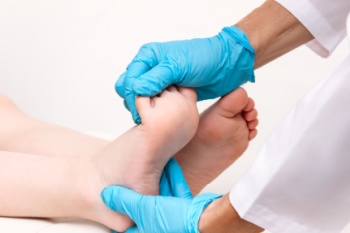
Cracked skin on the soles of children's feet is often due to dryness, frequent barefoot activity, or wearing shoes that do not provide enough support. One common condition linked to cracked soles in kids is juvenile plantar dermatosis, which causes dry, cracked, and sometimes painful skin on the balls of the feet and heels. This condition is often worsened by alternating between damp, sweaty, and dry conditions, like going from sweaty shoes to bare feet. To treat cracked soles, keep the skin moisturized with a gentle, fragrance-free cream, and ensure children wear breathable socks and properly fitting shoes to protect their feet. If cracks are deep, painful, or show signs of infection, it is suggested that you consult a podiatrist who can tailor treatment and guidance for your child to promote healing and comfort.
Cracked heels are unsightly and can cause further damage to your shoes and feet. If you have any concerns, contact one of our podiatrists from Podiatry Associates of Texas. Our doctors can provide the care you need to keep you pain-free and on your feet.
Cracked Heels
Cracked heels appear unappealing and can make it harder for you walk around in sandals. Aside from looking unpleasant, cracked heels can also tear stockings, socks, and wear out your shoes. There are several methods to help restore a cracked heel and prevent further damage.
How Do You Get Them?
Dry skin is the number one culprit in creating cracked heels. Many athletes, walkers, joggers, and even swimmers suffer from cracked heels. Age and skin oil production play a role to getting cracked heels as well.
Promote Healing
Over the counter medicines can help, especially for those that need instant relief or who suffer from chronic dry feet.
Wear Socks – Wearing socks with medicated creams helps lock in moisture.
Moisturizers – Applying both day and night will help alleviate dryness which causes cracking.
Pumice Stones – These exfoliate and remove dead skin, which allows for smoother moisturizer application and better absorption into the skin.
Change in Diet
Eating healthy with a well-balanced diet will give the skin a fresh and radiant look. Your body responds to the kinds of food you ingest. Omega-3 fatty acids and zinc supplements can also revitalize skin tissue.
Most importantly, seek professional help if unsure how to proceed in treating cracked heels. A podiatrist will help you with any questions or information needed.
If you have any questions, please feel free to contact our offices located in Arlington Weatherford, Mineral Wells, and Farmers Branch, TX . We offer the newest diagnostic and treatment technologies for all your foot care needs.

